Game Developer Interview Questions
Starting your career in game development? These interview questions are tailored for junior game developers and help assess your understanding of game design, programming, engines like Unity or Unreal, problem-solving skills, and teamwork. Whether you’re preparing for your first role or a new opportunity, this list will help you feel more confident and ready to impress.

Introductory Phase (About You)
1. Can you tell us a bit about yourself?
2. Why did you choose a career in game development?
3. What excites you most about this role?
4. What are your strengths as a developer?
5. What do you enjoy doing outside of work or studies?
Background and Experience Game Developer Interview Questions
1. Have you worked on any game development projects? Can you describe one?
2. What game engines have you used before?
3. What is your favorite game you’ve worked on, and why?
4. Have you ever worked as part of a team to develop a game?
5. How do you stay updated with trends in game development?
Technical/Tools Expertise Game Developer Interview Questions
1. What programming languages have you used for game development?
2. What do you know about physics engines in game development?
3. How do you optimize game performance?
4. What is your experience with game asset creation or integration?
5. Have you worked with AI in games?
Behavioral and Situational Game Developer Interview Questions
1. How do you handle tight deadlines in game development?
2. What would you do if a teammate disagreed with your design decision?
3. Describe a time when you worked on a challenging project.
4. How do you handle feedback or criticism on your work?
5. What would you do if your game feature didn’t work as intended?
Critical Thinking Game Developer Interview Questions
1. How would you design a game mechanic for a puzzle game?
2. What steps would you take to optimize a game with performance issues?
3. How would you prioritize features when working on a game with limited resources?
4. What would you do if players found a bug after release?
5. How do you decide on the balance between graphics quality and performance?
Performance-Based Game Developer Interview Questions
1. Can you write a basic script for character movement in a game engine?
2. How would you create a basic AI for an enemy character?
3. Can you design a simple level layout for a platformer game?
4. How would you debug a game crash?
5. What steps would you take to implement a multiplayer feature?
Problem-Solving and Analytical Thinking Game Developer Interview Questions
1. What would you do if a feature caused the game to crash on certain devices?
2. How would you fix a slow-loading level in a game?
3. What would you do if players found a game mechanic confusing?
4. How do you ensure the game is balanced for different player skill levels?
5. What would you do if a game feature exceeded its allocated budget?
Career Growth Game Developer Interview Questions
1. What do you hope to achieve in this role?
2. Where do you see yourself in 3-5 years?
3. What kind of games inspire you?
4. Are you interested in learning more about design, art, or sound for games?
5. What motivates you to grow as a game developer?
Introductory Phase (About You)
This section covers common game developer interview questions that help employers get to know you. These questions focus on your background, passion for game development, and what drives you as a junior developer.
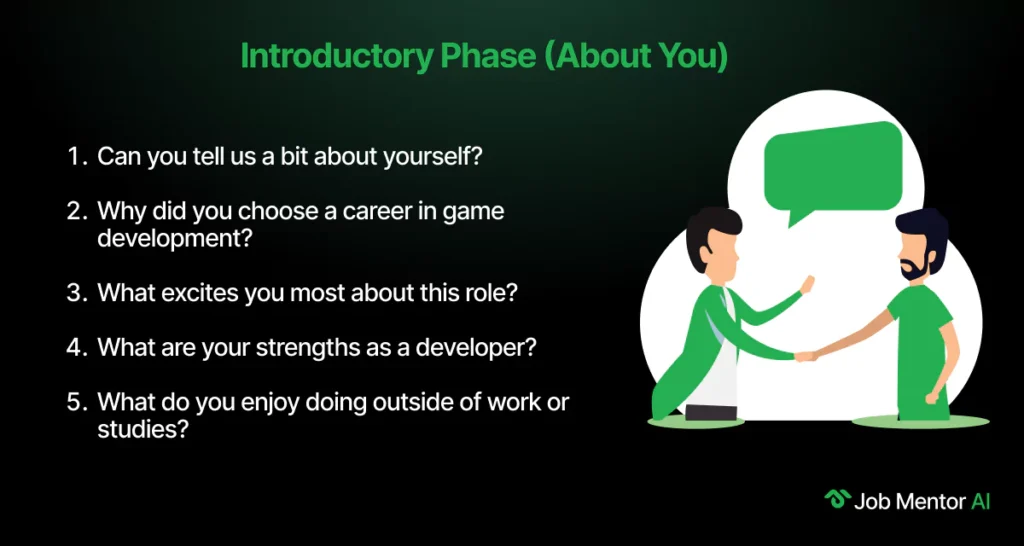
1. Can you tell us a bit about yourself?
What Interviewers Want:
A concise summary of your background, interest in game development, and any relevant experience or skills.
Strong Answer:
“I have a degree in Computer Science and a strong passion for game development. During my studies, I created a 2D platformer using Unity and C#, which allowed me to explore level design and scripting mechanics. I’m excited to bring my technical skills and creativity to a team where I can contribute to building engaging games.”
Poor Answer:
“I studied Computer Science and enjoy making games. I’ve used Unity and worked on small projects.”
2. Why did you choose a career in game development?
What Interviewers Want:
A clear passion for gaming, problem-solving, and creating engaging experiences.
Strong Answer:
“I’ve always been passionate about gaming and the creativity it fosters. I enjoy solving complex problems and bringing ideas to life through code. Game development combines my love for storytelling, design, and programming, making it the perfect career path for me.”
Poor Answer:
“I like playing games and coding, so game development seemed like a natural choice.”
3. What excites you most about this role?
What Interviewers Want:
Enthusiasm for contributing to game projects, learning from the team, or working with specific tools or engines.
Strong Answer:
“I’m excited about the opportunity to work on immersive projects and learn from a talented team. I admire your company’s innovative approach to game design and would love to contribute my skills in scripting and level design to create engaging experiences for players.”
Poor Answer:
“I’m excited to work on interesting projects and gain experience in game development.”
4. What are your strengths as a developer?
What Interviewers Want:
Confidence in skills like creativity, programming, problem-solving, or teamwork.
Strong Answer:
“My strengths include problem-solving, creativity, and a strong foundation in programming. I’m proficient in C# and Unity, and I’ve worked on projects where I built game mechanics, optimized performance, and collaborated with teammates to meet project goals.”
Poor Answer:
“I’m good at problem-solving and programming, especially with tools like Unity and C#.”
5. What do you enjoy doing outside of work or studies?
What Interviewers Want:
Insight into hobbies or activities that reflect creativity, technical skills, or a passion for games.
Strong Answer:
“In my free time, I enjoy creating small game prototypes to experiment with mechanics and improve my skills. I also play a variety of games to study their design and gather inspiration. Additionally, I enjoy participating in game jams, which allow me to collaborate and learn from other developers.”
Poor Answer:
“I like making small games, playing video games, and improving my skills in game development.”
Background and Experience Game Developer Interview Questions
This section focuses on your hands-on experience in game development. Interviewers use these game developer interview questions to learn about the projects you’ve worked on, the tools and engines you’re familiar with, and how well you collaborate with others. Whether you’ve participated in game jams or created your own indie games, your answers should reflect your technical skills, creativity, and growth as a developer.
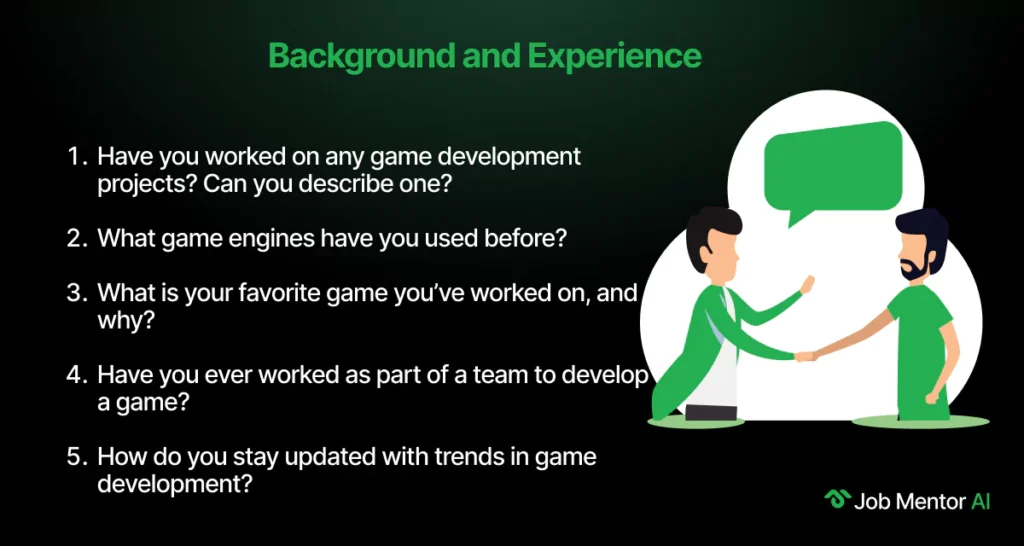
1. Have you worked on any game development projects? Can you describe one?
What Interviewers Want:
Examples of projects showcasing programming, design, or problem-solving skills.
Strong Answer:
“Yes, I developed a 2D platformer game during my final year of college using Unity and C#. I was responsible for designing levels, coding the player movement and collision mechanics, and implementing basic AI for enemies. One of the challenges was optimizing performance for smoother gameplay, which I solved by reducing unnecessary draw calls and optimizing physics interactions.”
Poor Answer:
“I worked on a platformer game in Unity where I created levels and programmed the mechanics.”
2. What game engines have you used before?
What Interviewers Want:
Familiarity with engines like Unity, Unreal Engine, or Godot.
Strong Answer:
“I have experience with Unity and Unreal Engine. In Unity, I’ve worked extensively with C# to create scripts for player controls and game mechanics. In Unreal Engine, I’ve explored level design and used Blueprints for prototyping mechanics. I’m also familiar with Godot for smaller 2D projects.”
Poor Answer:
“I’ve used Unity and Unreal Engine to create games and work on mechanics.”
3. What is your favorite game you’ve worked on, and why?
What Interviewers Want:
Passion for a project and your reasoning behind design or technical choices.
Strong Answer:
“My favorite project was a multiplayer puzzle game I developed during a game jam. I enjoyed designing puzzles that required teamwork and communication between players. It was rewarding to see how playtesters interacted with the mechanics and provided positive feedback on the cooperative elements.”
Poor Answer:
“My favorite project was a puzzle game I worked on because it was fun to create.”
4. Have you ever worked as part of a team to develop a game?
What Interviewers Want:
Insight into collaboration skills and your role in the team.
Strong Answer:
“Yes, during a game jam, I worked with a team of three. I handled the programming for character controls and mechanics, while my teammates focused on art and sound design. We communicated regularly using task management tools and delivered a complete game within 48 hours. It was a great experience in collaboration and time management.”
Poor Answer:
“I worked on a team during a game jam where we built a game together and completed it on time.”
5. How do you stay updated with trends in game development?
What Interviewers Want:
Commitment to continuous learning through blogs, forums, or gaming communities.
Strong Answer:
“I follow blogs like Gamasutra and Polygon for industry news and participate in forums like GameDev.net and Reddit communities. I also watch tutorials and attend webinars to learn about new tools and techniques. Additionally, I play a wide range of games to study emerging design trends and mechanics.”
Poor Answer:
“I read blogs and forums and play games to stay updated with the latest trends in game development.”
Explore these helpful interview question guides
Technical/Tools Expertise Game Developer Interview Questions
In this section of game developer interview questions, you’ll find common queries about your technical skills and tools experience. Interviewers use these to assess your knowledge of programming languages, game engines, performance optimization, asset handling, and AI in game development.

1. What programming languages have you used for game development?
What Interviewers Want:
Familiarity with languages like C++, C#, or Python.
Strong Answer:
“I have extensive experience with C# for scripting in Unity, where I’ve built player mechanics and AI behaviors. I’ve also worked with C++ in Unreal Engine to optimize game logic and with Python for creating tools to automate asset workflows.”
Poor Answer:
“I’ve used C#, C++, and Python for game development projects.”
2. What do you know about physics engines in game development?
What Interviewers Want:
Understanding of how physics engines handle collisions, gravity, and other real-world simulations.
Strong Answer:
“Physics engines simulate real-world phenomena like gravity, collisions, and friction. I’ve worked with Unity’s built-in physics engine to handle rigid body dynamics and implement collision detection. For example, I used it to create realistic movement in a 2D platformer.”
Poor Answer:
“Physics engines handle collisions, gravity, and other physical interactions in games.”
3. How do you optimize game performance?
What Interviewers Want:
Awareness of techniques like level-of-detail (LOD), object pooling, or reducing draw calls.
Strong Answer:
“I use techniques like object pooling to reduce memory allocation during runtime, optimize assets by lowering texture resolution where possible, and use level-of-detail (LOD) to minimize rendering complexity for distant objects. Additionally, I profile games regularly to identify bottlenecks and adjust accordingly.”
Poor Answer:
“I optimize performance by using object pooling and adjusting textures.”
4. What is your experience with game asset creation or integration?
What Interviewers Want:
Knowledge of working with 2D/3D assets and tools like Blender, Maya, or Photoshop.
Strong Answer:
“I’ve worked on integrating 3D models into Unity, ensuring proper scaling, collision settings, and textures. I’ve also used Blender to create simple assets and Photoshop for texture editing. For larger projects, I’ve collaborated with artists to ensure seamless asset implementation.”
Poor Answer:
“I’ve worked with 3D models and textures, integrating them into Unity.”
5. Have you worked with AI in games?
What Interviewers Want:
Familiarity with implementing AI behaviors like pathfinding or decision trees.
Strong Answer:
“Yes, I’ve implemented AI behaviors using Unity’s NavMesh for pathfinding and decision trees for NPC actions. For example, in a stealth game prototype, I created enemy NPCs that patrol predefined paths and dynamically react to the player’s presence.”
Poor Answer:
“I’ve worked with AI using NavMesh for pathfinding and programmed NPC behaviors.”
Behavioral and Situational Game Developer Interview Questions
Behavioral and situational questions are a key part of Game Developer interview questions. They help interviewers understand how you handle teamwork, deadlines, problem-solving, and feedback in real work scenarios. Preparing strong answers to these questions can set you apart and show your readiness for the role.
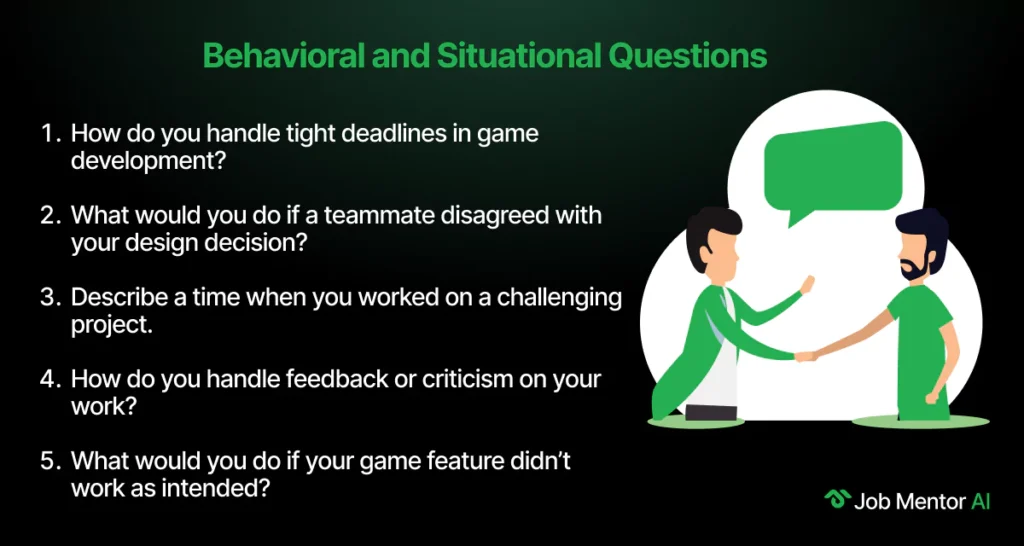
1. How do you handle tight deadlines in game development?
What Interviewers Want:
Time management and prioritization skills.
Strong Answer:
“I prioritize tasks by focusing on the features with the highest impact on the project’s goals. I break down work into smaller, manageable pieces and use tools like Trello or Jira to track progress. If needed, I collaborate with teammates to delegate tasks and communicate with the team lead about any constraints to adjust expectations.”
Poor Answer:
“I focus on the most important tasks and work faster to meet the deadline.”
2. What would you do if a teammate disagreed with your design decision?
What Interviewers Want:
Collaboration and conflict-resolution skills.
Strong Answer:
“I’d first listen to their perspective and try to understand their reasoning. Then, I’d explain my approach and the rationale behind my decision. If we still disagree, I’d suggest testing both ideas or seeking input from the team to find the best solution for the project.”
Poor Answer:
“I’d explain my decision and let the team decide what works best.”
3. Describe a time when you worked on a challenging project.
What Interviewers Want:
Problem-solving and perseverance in overcoming obstacles.
Strong Answer:
“During a game jam, my team faced a major challenge when the AI system for enemies wasn’t working as expected. I identified the issue in the behavior tree logic and restructured it to fix the problem. Despite the time constraints, we delivered a functional prototype that was well-received by players.”
Poor Answer:
“I worked on a challenging game jam project where we had to fix AI issues quickly to meet the deadline.”
4. How do you handle feedback or criticism on your work?
What Interviewers Want:
Openness to constructive criticism and a willingness to improve.
Strong Answer:
“I see feedback as an opportunity to improve. For example, when a peer pointed out that my UI design lacked clarity, I reviewed their suggestions, revised the layout, and tested it with players. Their input helped create a more user-friendly interface, and I learned to consider accessibility in future designs.”
Poor Answer:
“I listen to feedback and make changes to improve my work based on suggestions.”
5. What would you do if your game feature didn’t work as intended?
What Interviewers Want:
Problem-solving skills and ability to iterate and debug.
Strong Answer:
“I’d start by debugging the code to identify where the issue occurs. Once identified, I’d test potential solutions incrementally to avoid introducing new bugs. For example, if a physics-based mechanic failed, I’d review the physics engine settings and adjust the parameters until it behaved correctly.”
Poor Answer:
“I’d debug the code and make changes until the feature works as intended.”
6. Have you ever had to learn a new tool or engine quickly? How did you manage it?
What Interviewers Want:
Adaptability and eagerness to learn.
Strong Answer:
“Yes, I had to learn Unreal Engine for a project after primarily working in Unity. I started by following tutorials to understand the basics and then experimented with small projects to practice key concepts like Blueprints and level design. Within a week, I was confident enough to contribute effectively to the project.”
Poor Answer:
“I’ve learned new tools like Unreal Engine by watching tutorials and practicing on small projects.”
7. What would you do if a feature took longer to implement than planned?
What Interviewers Want:
Communication and problem-solving to manage expectations and adjust timelines.
Strong Answer:
“I’d communicate the delay to the team lead as soon as possible and provide a revised timeline. I’d also analyze why the delay occurred and adjust my approach to ensure progress. For example, I might break the feature into smaller tasks or seek help from a teammate if needed to stay on track.”
Poor Answer:
“I’d inform the team about the delay and work harder to complete the feature.”
Critical Thinking Game Developer Interview Questions
These game developer interview questions focus on your problem-solving and design skills. Interviewers want to see how you think creatively and logically to design mechanics, optimize performance, manage features, handle bugs, and balance graphics with gameplay.
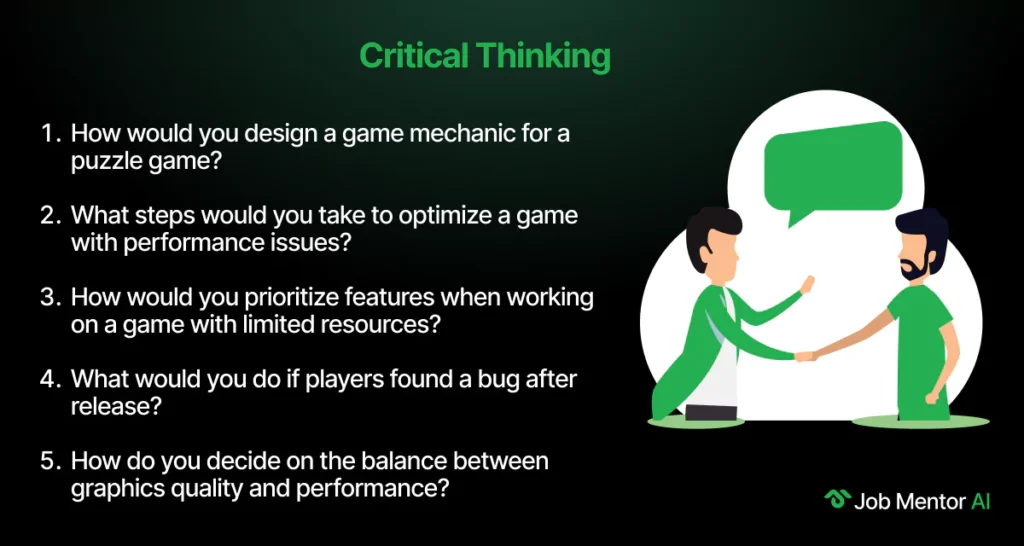
1. How would you design a game mechanic for a puzzle game?
What Interviewers Want:
Creativity and logical thinking in designing gameplay elements.
Strong Answer:
“I’d start by defining the core objective of the puzzle, such as arranging objects in a specific order. Then, I’d brainstorm mechanics that align with the theme, like rotating tiles or matching colors. For example, I might create a mechanic where players must rotate gears to unlock a door. I’d prototype it quickly, gather player feedback, and refine the mechanic to ensure it’s intuitive and engaging.”
Poor Answer:
“I’d think of a mechanic that fits the game and test it to see if it works.”
2. What steps would you take to optimize a game with performance issues?
What Interviewers Want:
A structured approach to identifying and resolving bottlenecks.
Strong Answer:
“I’d profile the game using tools like Unity Profiler to identify bottlenecks in CPU, GPU, or memory usage. Then, I’d address issues like reducing draw calls, optimizing textures, and implementing object pooling for frequently instantiated objects. Finally, I’d test the game on the target platform to ensure smooth performance.”
Poor Answer:
“I’d use profiling tools to find the problem and optimize areas like textures and memory usage.”
3. How would you prioritize features when working on a game with limited resources?
What Interviewers Want:
Awareness of balancing gameplay, visuals, and performance with user expectations.
Strong Answer:
“I’d prioritize features that directly impact core gameplay and player experience. For example, I’d focus on mechanics that define the game’s identity while deferring secondary features like advanced graphics. I’d also involve the team in the prioritization process to ensure alignment with project goals and deadlines.”
Poor Answer:
“I’d focus on the most important features first and leave less important ones for later.”
4. What would you do if players found a bug after release?
What Interviewers Want:
A clear process for addressing issues post-launch.
Strong Answer:
“I’d analyze the bug reports to understand its severity and impact. For critical issues, I’d prioritize a hotfix to resolve it quickly, ensuring thorough testing before deployment. I’d also communicate with players transparently, acknowledging the issue and outlining a timeline for the fix.”
Poor Answer:
“I’d fix the bug quickly and inform players that the issue has been resolved.”
5. How do you decide on the balance between graphics quality and performance?
What Interviewers Want:
Logical reasoning to align visual fidelity with platform capabilities.
Strong Answer:
“I consider the target platform and audience. For instance, on mobile, I’d prioritize performance by using optimized textures and simplified models, while on high-end PCs, I’d focus on delivering higher-quality graphics. I’d also implement scalable settings, allowing players to adjust quality to suit their hardware.”
Poor Answer:
“I focus on the platform’s capabilities and try to balance graphics and performance.”
Performance-Based Questions Game Developer Interview Questions
These game developer interview questions focus on your practical skills in coding, AI, level design, debugging, and multiplayer implementation. Interviewers look for clear, logical approaches to solving real game development problems.
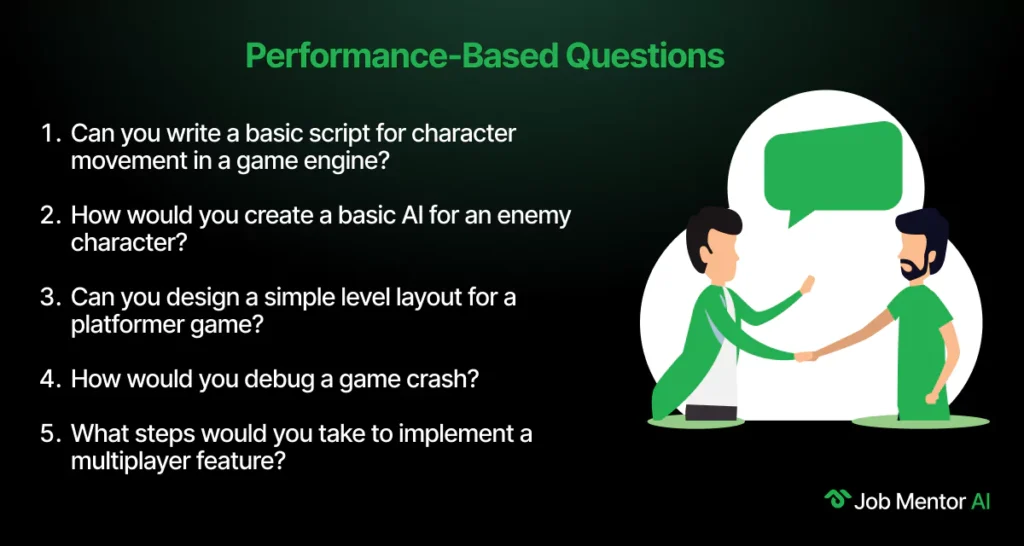
1. Can you write a basic script for character movement in a game engine?
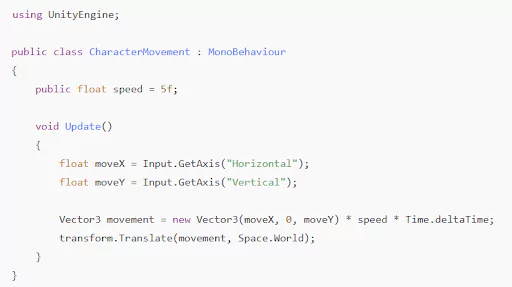
2. How would you create a basic AI for an enemy character?
What Interviewers Want:
Familiarity with pathfinding, state machines, or behavior trees.
Strong Answer:
“I’d use a finite state machine to manage the enemy’s behavior. For example, the enemy could switch between states like patrolling, chasing the player, and attacking. I’d implement pathfinding using Unity’s NavMesh system for movement and write conditions to transition between states based on player proximity or health.”
Poor Answer:
“I’d program the enemy to patrol and chase the player using pathfinding.”
3. Can you design a simple level layout for a platformer game?
What Interviewers Want:
Creativity in designing engaging and balanced game levels.
Strong Answer:
“I’d start by sketching the level layout, ensuring a balance of challenge and accessibility. For example, I’d include platforms with varying heights, a mix of moving obstacles, and collectible items placed strategically to guide the player. After prototyping in Unity, I’d test the level to ensure it’s engaging and fine-tune the placement of elements for difficulty balance.”
Poor Answer:
“I’d design a level with platforms, obstacles, and collectibles to make it fun and challenging.”
4. How would you debug a game crash?
What Interviewers Want:
Logical troubleshooting and debugging skills.
Strong Answer:
“I’d first reproduce the crash to understand the conditions that trigger it. Then, I’d examine the game logs for error messages or stack traces. Using breakpoints and debugging tools, I’d isolate the problematic code and test potential fixes incrementally to ensure the crash is resolved without introducing new issues.”
Poor Answer:
“I’d reproduce the crash, check the logs, and fix the code causing the issue.”
5. What steps would you take to implement a multiplayer feature?
What Interviewers Want:
Awareness of synchronization, networking, and server-client architecture.
Strong Answer:
“I’d use a networking solution like Photon or Unity Netcode to establish server-client communication. The first step would be synchronizing player positions and actions across clients. I’d implement server-side validation to prevent cheating and design an authoritative server model to manage game logic. Finally, I’d test the feature extensively to address latency and synchronization issues.”
Poor Answer:
“I’d use a networking tool to sync player actions and ensure the game logic works on both server and clients.”
Problem-Solving and Analytical Thinking Game Developer Interview Questions
These Game Developer Interview Questions focus on your problem-solving and analytical skills. Interviewers want to know how you handle technical challenges, optimize performance, balance gameplay, and work effectively with your team to create a smooth gaming experience.
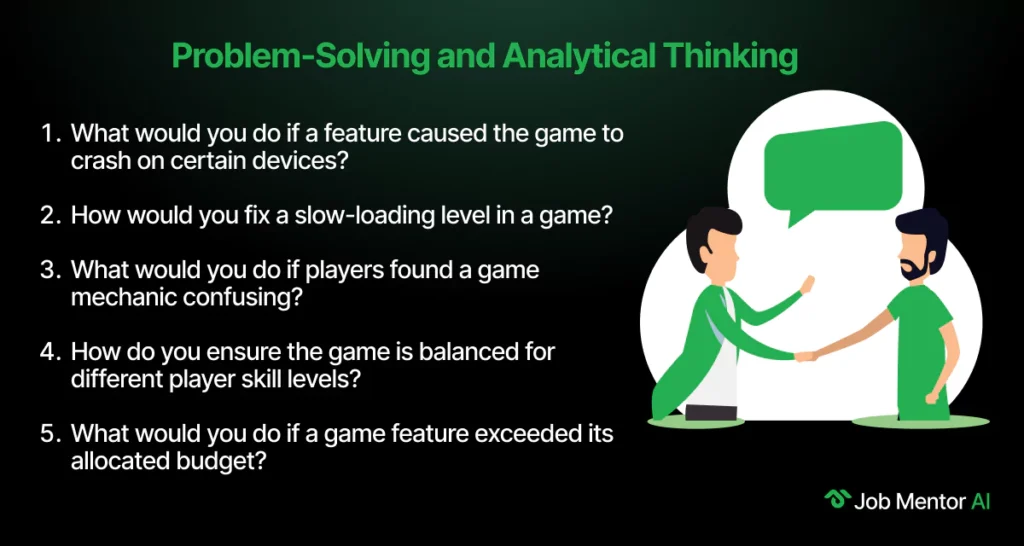
1. What would you do if a feature caused the game to crash on certain devices?
What the interviewer wants:
Analytical thinking and problem-solving to identify and fix compatibility issues.
Strong Answer:
“I’d start by reproducing the crash on the affected devices to gather more information. Then, I’d analyze the logs for error messages or clues about compatibility issues, such as memory usage or unsupported APIs. If necessary, I’d create a scaled-down version of the feature or optimize assets to make it compatible with those devices.”
Poor Answer:
“I’d test the feature on the affected devices and fix the issue to prevent the crash.”
2. How would you fix a slow-loading level in a game?
What the interviewer wants:
Awareness of optimization strategies like asset streaming or texture compression.
Strong Answer:
“I’d profile the level to identify bottlenecks, such as large textures or high polygon counts. I’d implement asset streaming to load only necessary assets during gameplay and compress textures to reduce loading times. Additionally, I’d review the code for any inefficiencies in asset loading and optimize where needed.”
Poor Answer:
“I’d reduce the size of assets and improve loading times by optimizing the level.”
3. What would you do if players found a game mechanic confusing?
What the interviewer wants:
Focus on usability testing and refining the mechanic based on feedback.
Strong Answer:
“I’d collect feedback through usability tests and surveys to understand the specific issues players are experiencing. Based on the feedback, I’d simplify the mechanic, add in-game tutorials, or adjust the UI to make it more intuitive. After implementing changes, I’d test the mechanic again to ensure it’s clear and engaging.”
Poor Answer:
“I’d listen to player feedback and make adjustments to improve the mechanic.”
4. How do you ensure the game is balanced for different player skill levels?
What the interviewer wants:
Awareness of testing, feedback, and difficulty scaling.
Strong Answer:
“I’d implement difficulty scaling by introducing multiple levels, such as easy, medium, and hard, with adjusted enemy behavior or resource availability. I’d also collect feedback from playtesting sessions with a diverse group of players to refine the balance further. Dynamic difficulty adjustment could also be used to tailor the experience in real-time.”
Poor Answer:
“I’d create multiple difficulty levels and test them with players to ensure balance.”
5. What would you do if a game feature exceeded its allocated budget?
What the interviewer wants:
Problem-solving skills to propose alternatives or scale down the feature.
Strong Answer:
“I’d assess the feature to identify areas where costs can be reduced, such as using simpler assets or reusing existing components. If scaling down isn’t feasible, I’d discuss alternatives with the team, like postponing the feature to a future update or replacing it with a more cost-effective solution.”
Poor Answer:
“I’d reduce the scope of the feature to fit the budget or replace it with something simpler.”
6. How do you approach creating a dynamic and engaging game loop?
What the interviewer wants:
Understanding of core gameplay mechanics and player engagement.
Strong Answer:
“I’d start by identifying the core mechanics that make the game enjoyable and ensure they are simple yet rewarding. Then, I’d introduce a progression system, like leveling up or unlocking new content, to keep players engaged. I’d also ensure the game loop has clear goals, feedback, and pacing to sustain interest.”
Poor Answer:
“I’d focus on making the core mechanics fun and add progression to keep players engaged.”
7. What steps would you take to ensure your game works across multiple platforms?
What the interviewer wants:
Knowledge of platform-specific requirements and optimization.
Strong Answer:
“I’d follow platform-specific guidelines for performance, input methods, and screen resolutions. I’d test the game thoroughly on each platform to identify compatibility issues and optimize assets, such as using scalable textures. I’d also use tools like Unity’s cross-platform build system to streamline deployment.”
Poor Answer:
“I’d test the game on different platforms and adjust the performance as needed.”
8. How would you address latency issues in a multiplayer game?
What the interviewer wants:
Awareness of networking optimization and server-client synchronization.
Strong Answer:
“I’d use techniques like client-side prediction to reduce the perceived lag and implement server-side reconciliation to maintain consistency. I’d also optimize network messages by reducing their size and frequency and choose servers with low latency to minimize delays.”
Poor Answer:
“I’d optimize the network code and reduce the size of data sent between the client and server.”
9. What would you do if your game experienced poor reviews post-launch?
What the interviewer wants:
Focus on identifying issues and delivering updates to improve player satisfaction.
Strong Answer:
“I’d analyze the reviews to identify recurring issues and prioritize fixes based on their impact on the player experience. I’d communicate transparently with players, acknowledging the problems and outlining a timeline for updates. After implementing fixes, I’d promote the updates to rebuild trust and attract new players.”
Poor Answer:
“I’d look at the reviews, fix the issues, and let players know about the updates.”
10. How do you handle integrating art, sound, and code in a cohesive way?
What the interviewer wants:
Awareness of collaboration between disciplines and maintaining a unified vision.
Strong Answer:
“I’d ensure clear communication between designers, artists, and developers to align on the game’s vision. I’d use tools like version control and asset management systems to streamline integration and regularly test builds to verify that all elements work seamlessly together. Iterative reviews help maintain consistency and address mismatches early.”
Poor Answer:
“I’d work with the team to ensure all elements are integrated smoothly and consistently.”
Career Growth
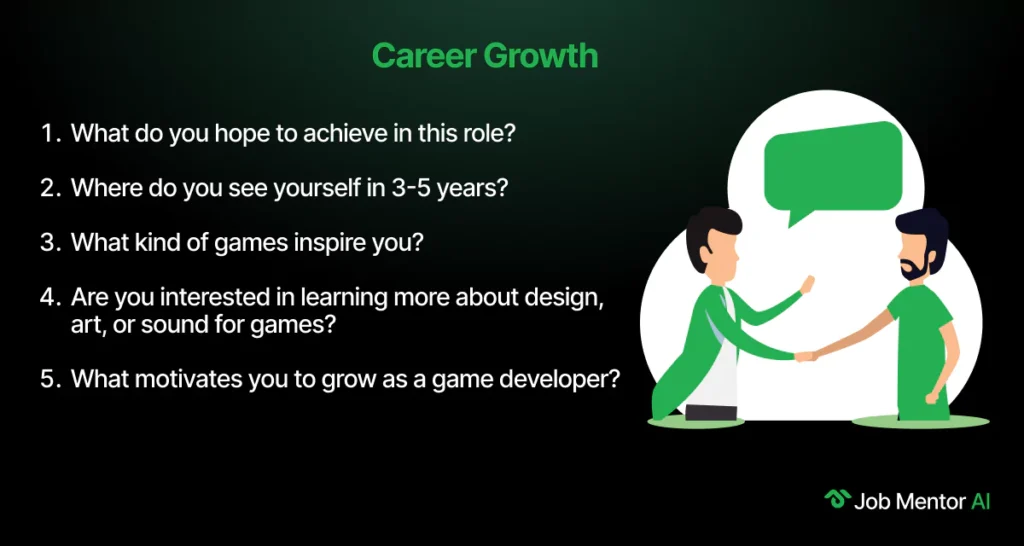
1. What do you hope to achieve in this role?
What Interviewers Want:
A clear desire to grow in game development and contribute to impactful projects.
Strong Answer:
“I hope to enhance my skills in game programming and design while contributing to the development of engaging and high-quality games. I want to learn from experienced teammates, work on challenging projects, and take on more responsibilities over time to grow into a well-rounded game developer.”
Poor Answer:
“I want to improve my skills and gain experience in game development.”
2. Where do you see yourself in 3-5 years?
What Interviewers Want:
A vision of long-term growth in game development, leadership, or technical expertise.
Strong Answer:
“In 3-5 years, I see myself as a lead developer or senior programmer, guiding a team and contributing to innovative game mechanics. I aim to deepen my technical expertise while also mentoring junior developers and playing a larger role in shaping the creative vision of projects.”
Poor Answer:
“I see myself working as a senior developer or leading a team in game development.”
3. What kind of games inspire you?
What Interviewers Want:
Passion for creating innovative and engaging experiences.
Strong Answer:
“I’m inspired by games that blend creative storytelling with innovative mechanics, like The Legend of Zelda: Breath of the Wild or Celeste. These games balance gameplay, visuals, and emotional engagement, and I aim to create experiences that resonate with players on multiple levels.”
Poor Answer:
“I’m inspired by creative and fun games that players enjoy.”
4. Are you interested in learning more about design, art, or sound for games?
What Interviewers Want:
Interest in expanding complementary skills that enhance game development expertise.
Strong Answer:
“Yes, I’m particularly interested in learning about game design to better understand how mechanics and player psychology influence engagement. I also want to explore how art and sound design contribute to creating immersive experiences, as these elements are crucial for bringing a game’s vision to life.”
Poor Answer:
“I’d like to learn more about design, art, and sound to improve my overall skills in game development.”
5. What motivates you to grow as a game developer?
What Interviewers Want:
A passion for delivering results and mastering the craft of paid advertising.
Strong Answer:
“I’m motivated by the idea of creating memorable experiences that players can connect with. Solving complex technical challenges and seeing ideas come to life in a game keeps me excited about continuous learning and improving my skills.”
Poor Answer:
“I’m motivated by my passion for games and the desire to keep improving as a developer.”
Need Help Preparing for Your Next Interview?
Preparing for an interview can be stressful, but with the right resources, you can feel confident and ready to succeed. Our resource hub for job interview success offers excellent tips and practical guidance to help you stand out and one of the best ways to prepare is through Mock Interview Practice, where you can refine your responses and boost your confidence.
Questions to ask interviewer
- What tools and platforms will I use in this role?
- What kind of projects will I work on?
- What opportunities are there for mentorship or growth?
- How does the game development team collaborate across disciplines?
- What are the next steps in the hiring process?
Game Developer Interview Questions
Table of Contents
Recommended Resources

Top 35 System Engineer Interview Questions 2025
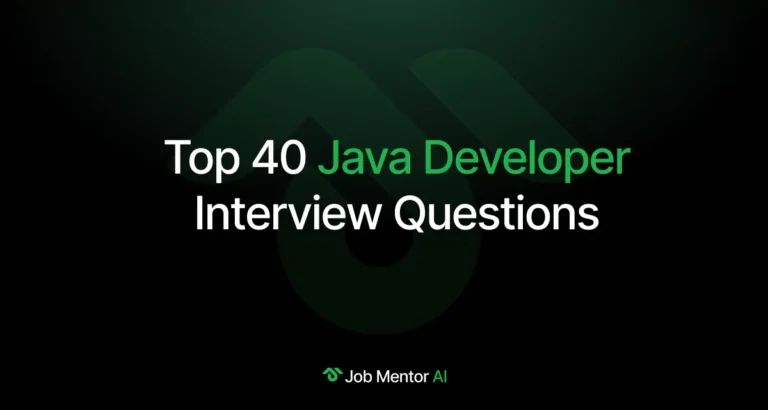
Top 40 Java Developer Interview Questions
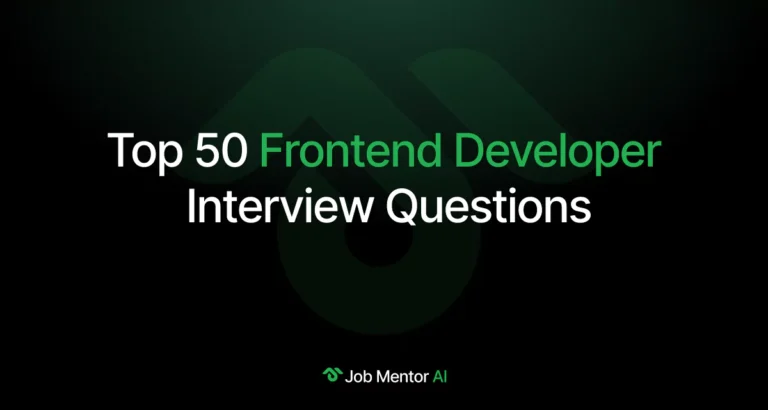
Frontend Developer Interview Questions
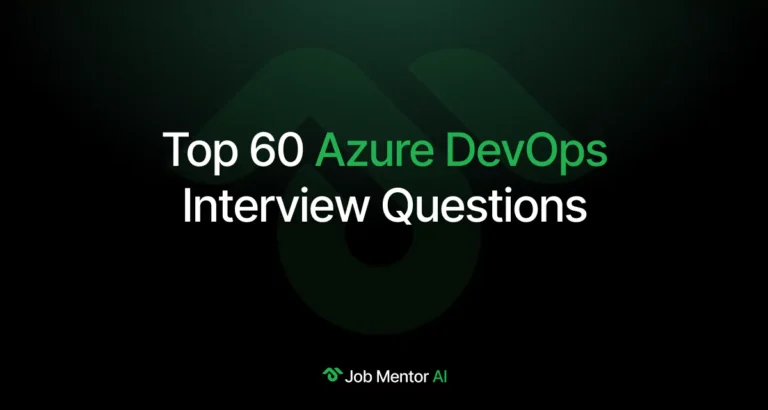
Top 60 Azure DevOps Interview Questions 2025
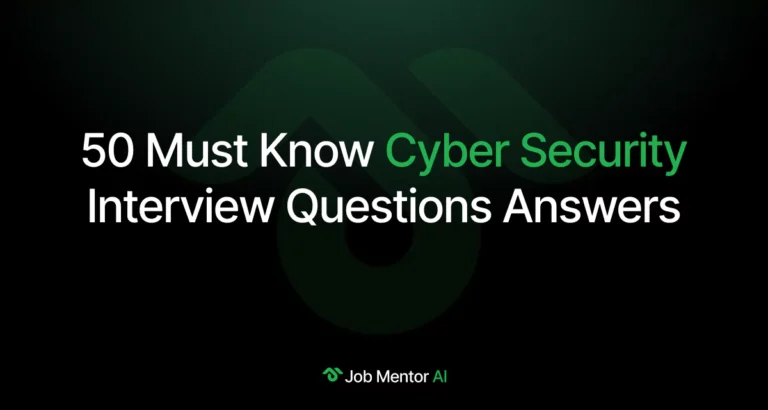
50 Must Know Cyber Security Interview Questions Answers
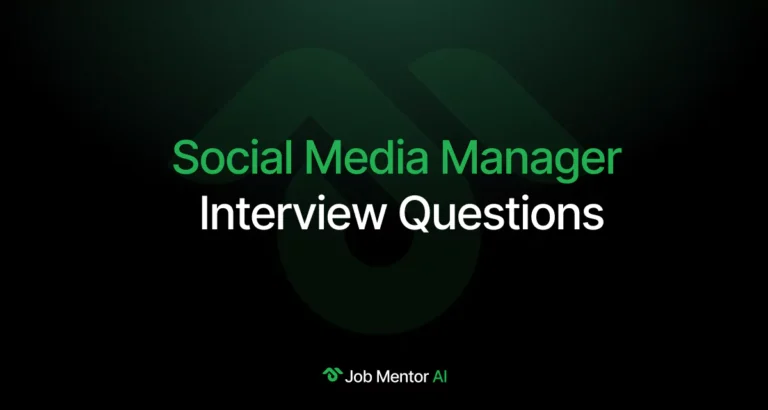
Social Media Manager Interview Questions


